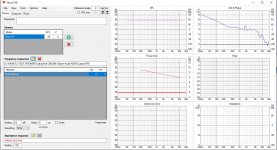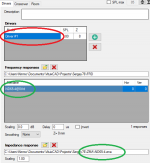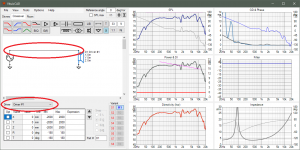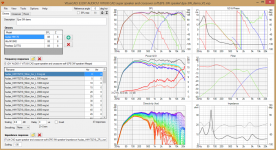Hi. I'm new bee with this program.Downloaded new version and stuck.
Simply can't upload any spl data.
Only one window "GD&Phase" is showing graph.Rest 3 is remain empty.
gdf and zma files been downloaded from parts-express. Tried create via SPL trase - no luck either.
Uninstall/reinstall.... Using Windows 10
Anyone have any thoughts? Maybe I missed one tiny tick somewhere?
Simply can't upload any spl data.
Only one window "GD&Phase" is showing graph.Rest 3 is remain empty.
gdf and zma files been downloaded from parts-express. Tried create via SPL trase - no luck either.
Uninstall/reinstall.... Using Windows 10
Anyone have any thoughts? Maybe I missed one tiny tick somewhere?
Attachments
Incredible soft - Thanks
After many years out from the DIY audio . I am have a new house with more space and that will allow me to experiment. I was using BassBox when I stopped my speaker building and whenI tryed to upodate my soft I was told I had to buy a new license.
You freesoft has given me the oppportunity to start experiementing again with a free soft with awesome capabilities.
Thanks

After many years out from the DIY audio . I am have a new house with more space and that will allow me to experiment. I was using BassBox when I stopped my speaker building and whenI tryed to upodate my soft I was told I had to buy a new license.
You freesoft has given me the oppportunity to start experiementing again with a free soft with awesome capabilities.
Thanks

Trying again to say thanks with pictures - thanks!!
After many years out from the DIY audio . I am have a new house with more space and that will allow me to experiment. I was using BassBox when I stopped my speaker building and when I tried to update my BB, I was told I had to buy a new license.
Your free soft has given me the opportunity to start experimenting again with a free soft with awesome capabilities.
Thanks
After many years out from the DIY audio . I am have a new house with more space and that will allow me to experiment. I was using BassBox when I stopped my speaker building and when I tried to update my BB, I was told I had to buy a new license.
Your free soft has given me the opportunity to start experimenting again with a free soft with awesome capabilities.
Thanks
Attachments
Rev. 2.0.50.0 (2020-04-30)
Main
* Added Minimum phase checkbox to Drivers tab to ignore measured phase of frequency responses.
* Crossover tab is selected when program is started.
Main
* Added Minimum phase checkbox to Drivers tab to ignore measured phase of frequency responses.
* Crossover tab is selected when program is started.
VCAD throws up an error when trying to derive T/S parameters. It does not think that added mass has caused resonant frequency to drop. Screen grab shows that it did drop.
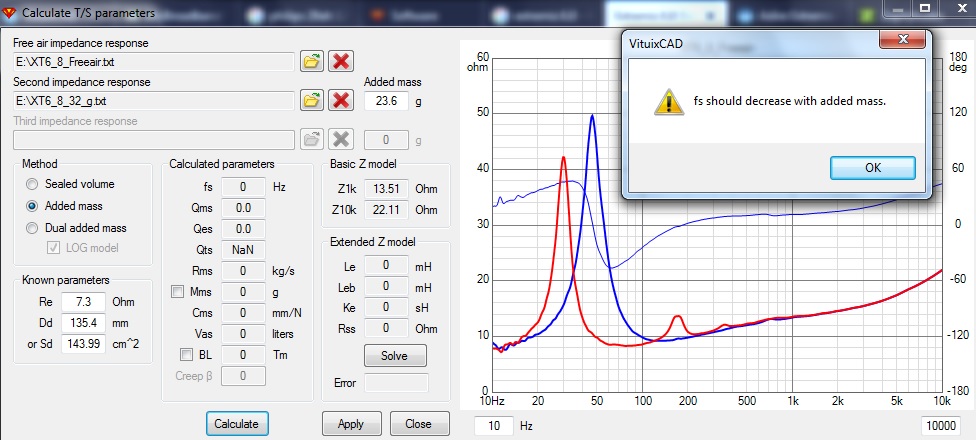
Info that might be of use: Adding mass to the cone causes a small peak to form just below 200Hz. Is it possible that VCAD is detecting that as the new resonant frequency? The impedance plot from SE also shows that phase goes through 0 degrees at more than one spot.
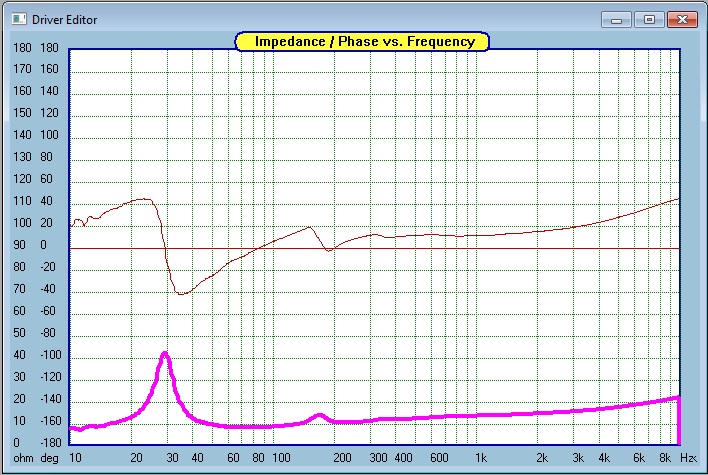

Info that might be of use: Adding mass to the cone causes a small peak to form just below 200Hz. Is it possible that VCAD is detecting that as the new resonant frequency? The impedance plot from SE also shows that phase goes through 0 degrees at more than one spot.

Do we "want" the (just added) Driver minimum phase checked?
Why would we want to damage measured phase?
Is it possible that VCAD is detecting that as the new resonant frequency?
I think so. Some filtering logic is probably needed to skip error due to second peak.
Why would we want to damage measured phase?I don't need or recommend MP checkbox to anyone
Thanks for the explanation, what I thought. I was not sure why you were adding this feature now so was checking it out...Agreed 100% on the need to get phase right from the get-go with the recommended measurements.
Hi Kimmosto:
Can I ask you what the best way to use Vituix to determine the maximum SPL capability of a complex speaker system like one of my arrays is?
My directivity data all derives from measurements taken at 1W1m. I then assemble the array in the crossover screen but I have had my listening distance set at 3m. What power level does the Total SPL then correspond to? It makes sense at least to me that it would be the 1W1m less the 3db per doubling of distance factor from 1m to 3m.
Then I equalize the array and see my filter has 10 db gain at 20 khz to compensate the 3db per octave array rolloff. So would I then conclude the input level is 10 db above the measurement level? Is that resulting 10W for each driver or divided over all drivers in the array? Thank God for room curves. 10W per driver is too much. With a room curve I'm back down to just 2db over 1W per driver. I see if I increase the power level with amplifier gain block, the filter curve moves up accordingly. Am I on the right track here?
I tried to use the crossover of driver checkbox in the enclosure tool to validate this thinking but all I'm getting is blank screens or flat lines. I dimly recall having used this in the past but perhaps that wasn't with an array. I do have more drivers than the tool supports directly but I'm not using it to figure box size.
Thanks for your help and a great tool!
Jack
Can I ask you what the best way to use Vituix to determine the maximum SPL capability of a complex speaker system like one of my arrays is?
My directivity data all derives from measurements taken at 1W1m. I then assemble the array in the crossover screen but I have had my listening distance set at 3m. What power level does the Total SPL then correspond to? It makes sense at least to me that it would be the 1W1m less the 3db per doubling of distance factor from 1m to 3m.
Then I equalize the array and see my filter has 10 db gain at 20 khz to compensate the 3db per octave array rolloff. So would I then conclude the input level is 10 db above the measurement level? Is that resulting 10W for each driver or divided over all drivers in the array? Thank God for room curves. 10W per driver is too much. With a room curve I'm back down to just 2db over 1W per driver. I see if I increase the power level with amplifier gain block, the filter curve moves up accordingly. Am I on the right track here?
I tried to use the crossover of driver checkbox in the enclosure tool to validate this thinking but all I'm getting is blank screens or flat lines. I dimly recall having used this in the past but perhaps that wasn't with an array. I do have more drivers than the tool supports directly but I'm not using it to figure box size.
Thanks for your help and a great tool!
Jack
I was not sure why you were adding this feature
Maybe I was just frustrated and tired. Users should already know that MP extraction with optional manual HP & LP slope adjustment has been available in Calculator tool. Fully automatic instant conversion is faster for some quick studies, though it's not recommended for "serious" speaker design.
Hi Kimmosto:
I tried to use the crossover of driver checkbox in the enclosure tool to validate this thinking but all I'm getting is blank screens or flat lines. I dimly recall having used this in the past but perhaps that wasn't with an array. I do have more drivers than the tool supports directly but I'm not using it to figure box size.
Jack
answering my own question about enclosure tool. crossover checkbox only works if driver entry is in driver database and the driver is selected there.
That is problematic for one of my drivers because its a planar and doesn't have a full set of T/S parameters. Even if I event some, the excursion info won't be meaningful. I wish I could see the voltage across it or current through it.
what the best way to use Vituix to determine the maximum SPL capability of a complex speaker system like one of my arrays is?
Standard line array theory works at low frequencies due to long wave length compared to distance differences between drivers, assuming that all drivers have the same unfiltered output signal. So sensitivity in free space is 10log
Everything become more complex above 200...600 Hz where sensitivity starts to drop (-3 dB/oct) and crossover could reduce number of effective drivers and cause more phase differences. Sorry but I haven't studied what are valid...the best method to evaluate SPL capacity.
Power dissipation window is one option in VCAD because it's able to show current and voltage of each driver (graph will be quite full with line array). dBSPL can be converted to excursion with known Sd assuming that radiator is ideal piston, but from terminal voltage to excursion needs few more parameters such as fc, Qt and USPL.
Main program tries to maintain measured sensitivity in SPL graphs to all listening distances. It just scales pressure of each driver with listening distance (set in options window) divided by distance from the driver to virtual mic. So if your measurement data is scaled to dBSPL/2.83V/1m, sensitivity will be the same with all listening distance settings.
In my opinion CBT is designed for something else than better FR sensitivity. It's one of the most inefficient speaker concepts at high frequencies: sensitivity of a single driver with cost of e.g. 32 drivers. Sound waves do not sum any better to long listening distances due to convex curved Z position.
Thanks.
It was confusing to see the main program keep the SPL level relatively constant when I do something like double the listening distance. I expect it to drop 3db per line array theory. Now that I know the program is doing that, I won't be confused any more, at least not about that .
.
I expect if I use the enclosure tool correctly, I will see power dissipation go up when I set a longer listening distance. I don't see that now. I had some pilot errors with enclosure tool when I first posted. Now I think I am past that but something isn't right. Checking the crossover of driver box in the enclosure tool changes my main tab axial response in a way that I can only undo by closing and reopening the project without saving. And I can't see driver power, because the power graph changes to a full scale of 50 kw.
I open my main program and see the axial response that I've equalized to. I open the enclosure tool which starts with neither crossover of driver nor feed boxes checked. The main screen is unaffected. The enclosure tool shows me a clean high pass SPL curve for a sealed TC9FD and a power curve with a peak level of .8W. As soon as I check the crossover of driver box, the SPL curve changes to look like the filter shape in the main screen BUT the power window changes to 50 kw full scale with a flat blue line at zero on the screen.
After a short delay, the axial response in the main screen changes, Equalization is no longer correct; seems to be too much bass and mid bass. Response changes only below 3 khz or so but I cross over to a tweeter array at 5 khz. This changed response doesn't revert back when I uncheck the box or close the enclosure tool. I have to be careful not to save the project when closing or I'll have to redo the equalization
Obviously, the scale of the power window is out of wack and prevents me from seeing what is happening in the crossover but the potentially permanent change to the axial response in the main screen is the most concerning -even if its just an affect of mismatch between box sizes in the enclosure tool and the directivity/measurements. The other screens look OK. Excursion looks a lot lower than I expected but it does change when crossover of driver is checked.
I can zip up my files, perhaps create a simpler test case if you need them to debug.
Jack
It was confusing to see the main program keep the SPL level relatively constant when I do something like double the listening distance. I expect it to drop 3db per line array theory. Now that I know the program is doing that, I won't be confused any more, at least not about that
I expect if I use the enclosure tool correctly, I will see power dissipation go up when I set a longer listening distance. I don't see that now. I had some pilot errors with enclosure tool when I first posted. Now I think I am past that but something isn't right. Checking the crossover of driver box in the enclosure tool changes my main tab axial response in a way that I can only undo by closing and reopening the project without saving. And I can't see driver power, because the power graph changes to a full scale of 50 kw.
I open my main program and see the axial response that I've equalized to. I open the enclosure tool which starts with neither crossover of driver nor feed boxes checked. The main screen is unaffected. The enclosure tool shows me a clean high pass SPL curve for a sealed TC9FD and a power curve with a peak level of .8W. As soon as I check the crossover of driver box, the SPL curve changes to look like the filter shape in the main screen BUT the power window changes to 50 kw full scale with a flat blue line at zero on the screen.
After a short delay, the axial response in the main screen changes, Equalization is no longer correct; seems to be too much bass and mid bass. Response changes only below 3 khz or so but I cross over to a tweeter array at 5 khz. This changed response doesn't revert back when I uncheck the box or close the enclosure tool. I have to be careful not to save the project when closing or I'll have to redo the equalization
Obviously, the scale of the power window is out of wack and prevents me from seeing what is happening in the crossover but the potentially permanent change to the axial response in the main screen is the most concerning -even if its just an affect of mismatch between box sizes in the enclosure tool and the directivity/measurements. The other screens look OK. Excursion looks a lot lower than I expected but it does change when crossover of driver is checked.
I can zip up my files, perhaps create a simpler test case if you need them to debug.
Jack
Hi everyone, hope your audio endeavors are most excellent.
Say I want to use Acourate software and want to pair it with a DSP or Active crossover. Is there anything else besides MiniDSP that you would recommend ?
Any suggestion is welcome since I want to explore my options.
Many Thanks.
Say I want to use Acourate software and want to pair it with a DSP or Active crossover. Is there anything else besides MiniDSP that you would recommend ?
Any suggestion is welcome since I want to explore my options.
Many Thanks.
Hello kimmosto !
As usual ! Thanks you for this tool and for all your efforts put into this !
I didn't find with the 'search' function of this thread one information, so I asking ou directly
It's about the "Measurement Preparations with REW" document, precisely, the "Export far field responses of tweeter" chapter.
I understand that you advice to select axial response “ hor 0”, adjusting time window, and to "apply windows to all"
That's mean to me that the hor 0 ref time will be used on each other measurements. (Current version of REW allow to keep the ref time of indiciduals measurements).
Do I understand well ? Phase is for me an hard topic !
In the same way, as the medium and woofer are shorter, I don't get if I must use the woofer driver (for example) hor 0 ref time for its other measurements or the tweeter hor 0 ref time ?
See you !
PS: do you have a "buy me a beer" pot ? Like Tipee, Paypal, other ?
As usual ! Thanks you for this tool and for all your efforts put into this !
I didn't find with the 'search' function of this thread one information, so I asking ou directly
It's about the "Measurement Preparations with REW" document, precisely, the "Export far field responses of tweeter" chapter.
I understand that you advice to select axial response “ hor 0”, adjusting time window, and to "apply windows to all"
That's mean to me that the hor 0 ref time will be used on each other measurements. (Current version of REW allow to keep the ref time of indiciduals measurements).
Do I understand well ? Phase is for me an hard topic !
In the same way, as the medium and woofer are shorter, I don't get if I must use the woofer driver (for example) hor 0 ref time for its other measurements or the tweeter hor 0 ref time ?
See you !
PS: do you have a "buy me a beer" pot ? Like Tipee, Paypal, other ?
- Home
- Design & Build
- Software Tools
- VituixCAD
